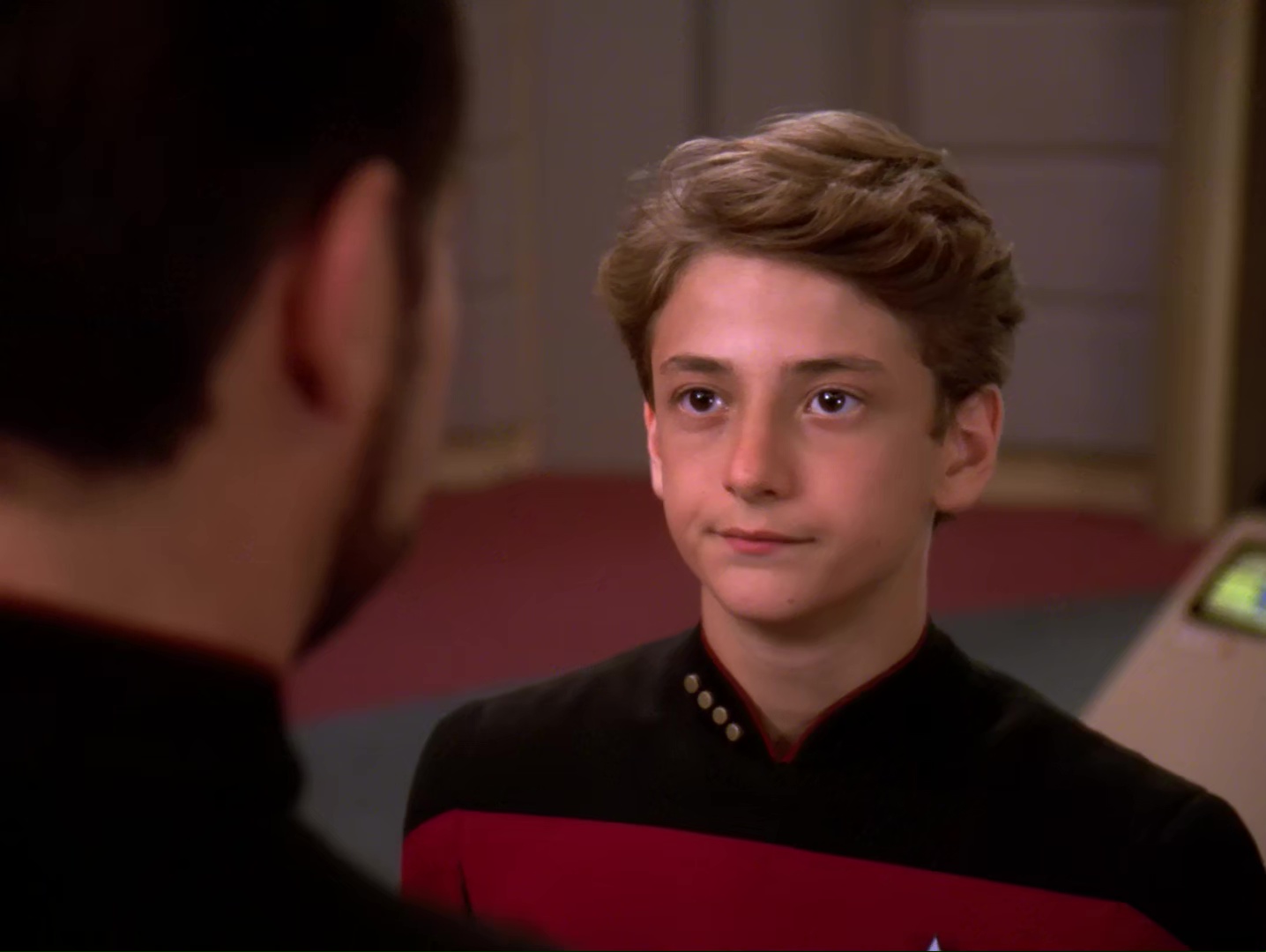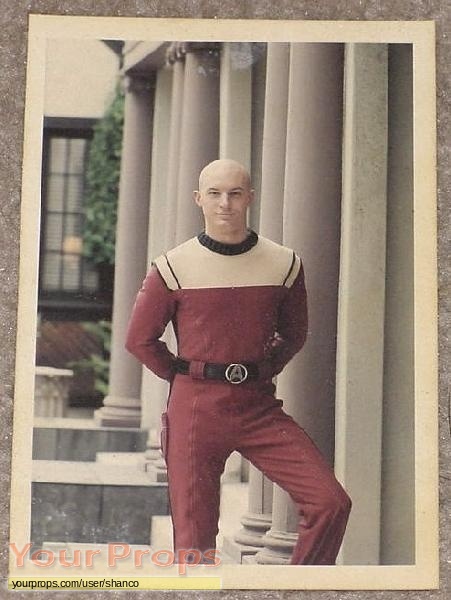The Picards are likely Changelings. After all,Jean-Luc changed his appearance quite a bit over the years!Picard's nephew not only changed appearance, but somehow didn't age a day in four years. In fact, I think he actually grew younger.




The Picards are likely Changelings. After all,Jean-Luc changed his appearance quite a bit over the years!Picard's nephew not only changed appearance, but somehow didn't age a day in four years. In fact, I think he actually grew younger.




 ).
).
The truth behind the discrepancy: The version shown in "Yesterday's Enterprise" was the real McCoy; the version on the observation lounge wall was sculpted by a 24th-century descendant of Robert Comsol...one who was obsessed with an early, unused concept drawing of the Ambassador class.
 That’s a good one! I’ll make sure to pass that on to my grand-children!
That’s a good one! I’ll make sure to pass that on to my grand-children! ) as non-canon, I better make sure I have solid evidence beyond a shred of doubt to make such kind of judgement…and in Part II we shall see and - if you like - discuss how “solid” the evidence actually is.
) as non-canon, I better make sure I have solid evidence beyond a shred of doubt to make such kind of judgement…and in Part II we shall see and - if you like - discuss how “solid” the evidence actually is.
None of the above matters. The theme for FC was that the ships represented all the Enterprises. Why? Because John Eaves said so, and he trumps whatever some fan on the TrekBBS thinks. Plus, each of his models is named the Enterprise, as can clearly be seen here.The TNG conference lounge sculpture wall
was approved and authenticated by the original TOS & TNG producers/creators Gene Roddenberry and Bob Justman, so I think that accounts for quite a lot (especially given its onscreen exposure during the first four seasons - and beyond “Yesterday’s Enterprise”) and takes precedence over the sculpture walls of the Enterprise-E (just in case we intend to talk about intentions, I think “first comes, first served” is appropriate).
The theme of the “D” sculpture wall is obviously clear (“large ships named Enterprise”) because of the presence of the aircraft carrier CVN-65 USS Enterprise.
With the sculpture walls of the “E” it is not. CVN-65 is missing. Then the theme is “spaceships named Enterprise”? Apparently not, because the ringship XCV-330 is missing. Is it “warp drive spaceships named Enterprise”? Fans of ENT will notice that the Enterprise NX-01 is missing, so apparently that’s not the theme neither. So what is the theme?
What's the difference between the ENT B on the ENT D wall and the ship we saw in "Generations?" I'm not seeing it. It's just an Excelsior class, isn't it?
What's the difference between the ENT B on the ENT D wall and the ship we saw in "Generations?" I'm not seeing it. It's just an Excelsior class, isn't it?

What's the difference between the ENT B on the ENT D wall and the ship we saw in Generations? I'm not seeing it. It's just an Excelsior class, isn't it?
Seconded.
The version of the Enterprise-B seen in Generations had added bits on the secondary hull.
The reason that was done is because physical models were still used at that point (1994), and they needed to be able to depict battle damage without damaging the rest of the Excelsior-class model. So the added bits were placed there, where the Nexus damage would later occur.



Tough indeed but I dare to say not impossible, and though it turned busy in my real life just as I started this thread I look forward to pull this through, especially that on February 6th something popped up on YouTube (and I have absolutely nothing to do with it!) which is the best kind of encouragement I could ever think of, but if I linked it here and now the BBS member going by the name of the Cardassian antagonist would probably pump up the volume of his scatological rants, which are neither appropriate, applicable or helpful.
 I'm not stopping you from posting anything, so stop insinuating that I am. And if you didn't want any criticism about your post, you should have made that clear in the OP. But because this is an effort to sway our opinions toward what you personally believe, I have every right to speak my mind and provide proof to the contrary, no matter how much you dislike having to hear it.
I'm not stopping you from posting anything, so stop insinuating that I am. And if you didn't want any criticism about your post, you should have made that clear in the OP. But because this is an effort to sway our opinions toward what you personally believe, I have every right to speak my mind and provide proof to the contrary, no matter how much you dislike having to hear it.What you don't seem to grasp is that it doesn't matter who made or approved the sculptures, or how much screentime some background artwork got. Once that ship appeared in YE, that artwork was invalidated just like that. If you want to convince yourself otherwise, that's fine. But don't expect many people to agree with you, especially when you say things like "I thought only that was the commonly agreed upon canon from which we should conclude our findings?" as if there was any kind of consensus about that with the other responders.Although we have now seen nice close ups of these plastic ships from the conference lounge of the Enterprise-D and the intention is obvious, I hold the intentions of the original TOS & TNG producers (which I already mentioned anticipating Dukhat's "move) and the amount of screentime featuring the conference lounge of the "D" in four seasons of TNG versus the few moments of the conference lounge of the "E" in FC and NEM against that. Add to this that we never saw those plastic models close enough onscreen (I thought only that was the commonly agreed upon canon from which we should conclude our findings?) to actually read what the tags say.
In summary: for an average viewer of the episodes and films the theme of the sculpture wall in the conference lounge of the "D" is obvious (because of the aircraft carrier CVN-65) while the one of the "E" is ambiguous.

More drama, Bob?I'm not stopping you from posting anything, so stop insinuating that I am.
This drama you're alluding about shi***** all over Probert's design is quite unwarranted.
I have every right to speak my mind and provide proof to the contrary, no matter how much you dislike having to hear it.
Let the other forum members judge for themselves what they think of your opinions.
But you know what? One plus one doesn't equal three. It equals two. And no student who left class that day was convinced otherwise.
It may have been a good thing for general audiences, then, but from a fannish point of view I think it's lame - and would like to look forward to a "special" or "artists" edition of TNG in the future where it should be easy on any HD screen to distinct Probert's [Ambassador Class] starship design from the Enterprise-D.
Bob


 ) as apparently suggested in “Yesterday’s Enterprise”.
) as apparently suggested in “Yesterday’s Enterprise”.@ BillJ
Personally I think that what you suggest is exactly what was going on in the minds of the TNG producers.
I believe they were just afraid that because of the similarities between Probert's Ambassador and Galaxy Class audiences might have mistaken one for the other, considering the small TV screens of the late 1980's.
Putting the Enterprise-D next to an Excelsior Class starship definitely created the contrast to distinct one from the other but so we ended up with all these Excelsior Class starships, instead.
It may have been a good thing for general audiences, then, but from a fannish point of view I think it's lame - and would like to look forward to a "special" or "artists" edition of TNG in the future where it should be easy on any HD screen to distinct Probert's [Ambassador Class] starship design from the Enterprise-D.
Bob
And yet, still not a sign of the divine. Your "treatise" is a case study for wishful thinking and rationalization beyond the breaking point. It's a beautiful example of "shoehorning" to no useful end as it won't have any change on canon.
I find it remarkable that you cast judgement before having read the parts that are yet to come, I clearly used Part I and Part II (posted that a few minutes ago) headings to get that across (and in case you had a preview of the draft I'd like to point out that I have changed structure and flow of the treatise to get the message better across).
In my discussions with Bernd Schneider he applied that "shoehorning" argument and used these K/S fan stories as an example for over-interpretation. While these K/S writers have no evidence for their claims, other than wishful thinking, I will present evidence. How to evaluate the evidence is another thing, suffice to say the treatise won't be without substance.
Bob
We use essential cookies to make this site work, and optional cookies to enhance your experience.
